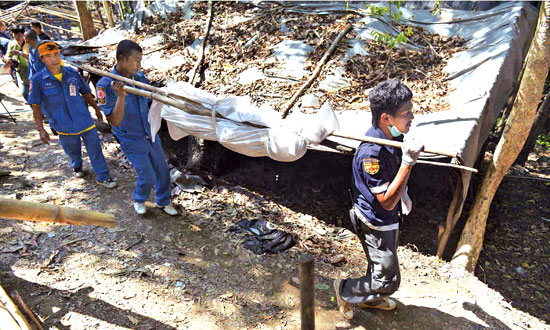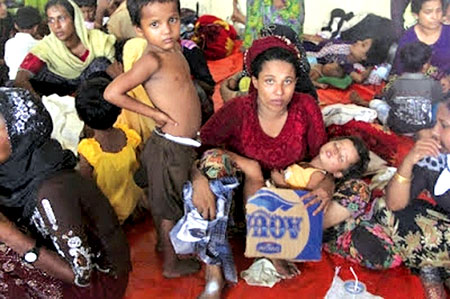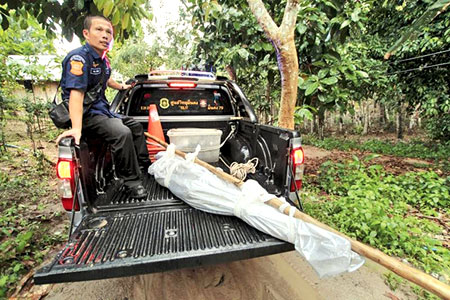Sold for ransom
On the trail of Thailand’s human traffickers:
by Jonathan Head
Earlier this month, I accompanied a group of Thai volunteers through
the steamy mangrove forest of an island on the Andaman coast. They were
following up hazy reports of unmarked graves on the island; it was known
to have been used by traffickers to hold large groups of migrants while
they waited for transport south towards the Malaysian border.
 |
|
Thai officials carry a body
believed to be a migrant from Myanmar [AFP] |
They dug down deep into the waterlogged soil, before the first
fragments of bone appeared. Then they pulled at a soggy wet cloth. It
was a dress. Inside were the yellowing bones of a woman. Who she was, or
how she died, we still do not know. But it is almost certain she was one
of the migrants.
She must have endured a gruelling sea journey to reach this desolate
spot. Had she lived, the ordeal ahead of her, on her route to a better
life in Malaysia, might have been even worse.
The human trade
Last October, I was in almost exactly the same area. We had dashed
down from Bangkok on news that a group of migrants had been rescued by
officials in the district of Takua Pa. In the community hall, we found
81 men in acute distress, weeping and praying.
Rohingya Muslims have been fleeing here from mistreatment in Myanmar
for several years – but this time, the men were not Rohingyas. They were
Bangladeshis. And some of them told us they had been forced on to the
boats that transported them here.
District chief Manit Pianthong took us back to where he had found
them, in the jungle not far from the site of the woman’s grave. They had
been starved and beaten over a period of several days.
Manit told us his district had long been used by human traffickers to
transfer migrants from boats to trucks. He wanted to stamp it out. But
he was getting little help from the central government, or from local
law enforcement.
Over several days, I watched him dealing with angry phone calls from
government officials and police, criticizing him for talking to the
media, and demanding that he send the Bangladeshis to immigration
detention centres. It was an open secret that many of the migrants sent
there were simply sold back to the traffickers.
Manit used volunteers from his own staff to go out searching for the
holding camps. He put a 24-hour checkpoint on the main road route south
to stop the truckloads of migrants. He put the word out among fishing
communities to alert him if they spotted any boats coming in.
The arrival of growing numbers of Bangladeshis, together with the
Rohingyas, showed that the trade in humans was expanding. And no wonder.
It was immensely profitable.
The business model
The humidity under the rubber trees was suffocating. A young man in a
bright orange shirt moved quickly ahead of me, as I puffed uphill. There
was no discernible path. Then he stopped and began talking quickly.
 |
| The misery of undocumented
migrants [Myanmar Times] |
 |
| Rescue workers transport
one of the bodies found at an abandoned camp in Thailand’s
southern Songkhla Province |
Six months earlier he had been living here, he said, with 600 others.
He lay down among the fallen leaves and insects to show where they
slept, without shelter. They took us to a tent over here, he gestured,
and made us phone our parents to demand money. If they could not pay, we
were beaten. And over there, he pointed, that is where we saw women
being raped. People died, and they sent in trucks to take away the
bodies.
This was the business model. The Thai trafficking networks bought the
migrants by the boatload. The price for a cargo of 300 people, we were
told by several sources, including Thai police, was US$20,000 (£13,000;
€18,000) or more. Then the migrants were held in the jungle until their
families paid a ransom, usually US$2,000 - US$3,000 per person, a huge
sum for people usually doing low-end jobs in Malaysia.
So how were the traffickers able to conduct this business in the
midst of Thai villagers? The camp I saw was just 30 minutes drive from
the city of Hat Yai. They involved the local community. A young Thai
Muslim man from a village near the camp, explained how his community was
sucked into the trafficking business. A few years back, he said, he had
been out hunting birds when he came across migrants, including children,
being beaten in the camp. After that he discreetly started offering
shelter to migrants who escaped.
“The whole community is involved”, he said. “It’s because of the
money. The traffickers hire everyone. They hire people to keep watch on
the camps, to carry food for the Rohingyas. They go round all the houses
here, hiring people.” With the price of rubber, their main crop,
plunging, it was a tempting alternative.
He told me the young men were also offered drugs as an inducement. So
if the migrants escaped – there were no fences – they were likely to be
caught, and risk violent punishment by the camp guards.
The BBC has seen evidence of the complexity of the smugglers’
operation at sites in southern Thailand. In the Takua Pa District,
Bangladeshi migrants were rescued by authorities close to the site where
the grave of a woman, thought to be a migrant, had been found months
later.
On 14 May, the BBC found a vessel that had been reported stranded at
sea in waters off southern Thailand, near the Malaysian island of Koh
Lipe, after local fishermen spotted the boat. It later arrived in
Indonesia.
Half an hour from the city of Hat Yai the BBC saw another site used
as a camp by smugglers – with help from the local community.
Official involvement
None of this would have been possible, though, without official
connivance. Just how high the involvement went is still unclear. But it
must have been very high.
Towards the end of last year, I was given a briefing by a senior
police officer who knows a lot about the human trafficking trade. He
told me of at least one huge camp, right on the border with Malaysia,
where 1,000 people could be held.
Why did he not shut it down, I asked. He laughed. “You know the
border is a military zone,” he said. “As a police officer, I can do
nothing there without military approval.”
He had never got that approval. Why did he not go to General Prayuth
Chan-ocha, who led last year’s coup, and who had pledged to end
trafficking? If I try that, he said, the traffickers will be told even
before I see him, and they will quickly move the camp. All he could do,
he said, was to observe.
Six months later, the first mass grave, containing 26 bodies, was
found in the same camp that he had been impotently watching.
It became difficult to work out who was involved, and who was not.
One local police chief told us of his efforts to stop the trade.
He offered us the use of his boat to go and look for more. A day
later, a military unit who had taken us out on patrol with them told us
the same police chief was deeply implicated in trafficking.
But then their own commitment suddenly looked uncertain when they
refused to land us, as promised, in villages we were passing where
migrants were believed to have been hidden.
One officer showed us several sheets of paper detailing his
investigations into prominent business figures in Ranong, a province
well-known for its trafficking links. He had names, phone numbers, times
of calls, evidence of a well-connected network. This information, he
said, had been passed on to the central government. The clear
implication was that the government was doing nothing. That officer has
now been transferred.
“Everybody knew those camps were there,” says Phil Robertson from
Human Rights Watch. “It wasn’t just the villagers in the vicinity who
were working with the camps and serving as lookouts.”
Will it stop?
“These are areas at the Thai-Malaysia border which are militarized.
So you had police and military in those areas. There is no way somebody
would be able to operate camps of that size without somebody signing off
in exchange for a ‘packet’.”
I stood before a large crowd of Rohingyas, in another local
government hall, two days after they had been intercepted. Their guards
had been locked up in the police cell next door and the police chief was
questioning them and going through their mobile phones in an effort to
find out who their bosses were.
I had a question for the Rohingyas. How many of them were worried
about whether their families could pay the ransoms the brokers would
demand? Almost every one of them raised his hand.
“We don’t want to come here,” said Mohammad, a teacher from
Rathedaung, in Rakhine State. “We don’t want to leave our motherland.
But we don’t have anywhere to escape with our lives. The Myanmar
Government is so bad. They beat us, they shoot us.”
But Mohammad had little idea what awaited him in the camps, if he
escaped, and ended up back in the hands of the traffickers.
Later, many of his group did just that, a military source told us,
after they had been transferred to the immigration detention centre in
Ranong. Possibly they were sold back to the traffickers, as many had
been before them. They were all desperate to reach Malaysia, where there
were jobs, families and hope of a better life.
Until their treatment by the Burmese Government improves, Rohingyas
will continue to flee.
But the Bangladeshis have a choice. Only some of them were forced
onto the boats. Most were persuaded to board them, by rosy talk of
well-paid jobs. Once they understood the brutal reality of the trade,
many of them wanted to go home.
The Thai ransom business had become so lucrative that the traffickers
have extended their operations into Bangladesh, where there is already a
well-established network of labour brokers. If the networks are broken,
the numbers boarding rickety boats will probably fall sharply.
The crackdown
For months we talked to military and police officers who seemed
genuine in their wish to stop trafficking. They said they were making
progress, but they never seemed to have enough evidence to arrest, or
even question, powerful figures in the provinces Ranong, Satun and
Songkhla, who were believed to be running the business. What seemed to
be missing was political will.
It was the discovery of the first mass grave that shocked the
government into action.
The many appalling tales of brutalities we had heard, from people
held in the camps, were vindicated by the bones exhumed from the damp,
tropical soil.
At the time of writing, more than 80 arrest warrants have been
issued, and more than 30 people arrested. They include one very
prominent businessman from Satun, a few government officials, but so far
no military officers. More than 50 police officers have been
transferred.
Will this anti-trafficking drive be sustained?
“We believe there are some much more senior people that were involved
in making money off these rackets than have come to light so far,” says
Phil Robertson. “There is a lot more to be done, a lot more to be
uncovered.”
(BBC)
Jonathan Head has been investigating Thailand’s human trafficking
trade for six months
------------
Speed read:
Rohingya Muslims mainly live in Myanmar, where they have faced
decades of persecution.
Rights groups say migrants feel they have “no choice” but to leave,
paying people smugglers to help them.
The UN estimates more than 120,000 Rohingyas have fled in the past
three years.
Traffickers usually take the migrants by sea to Thailand then
overland to Malaysia.
Thailand recently began cracking down on the migrant routes, meaning
traffickers are using sea routes instead.
|

